Isn’t this just the cutest little moppet you’ve ever seen? It’s sitting on a tree branch, all fluffy and cuddly. Do NOT pick it up!
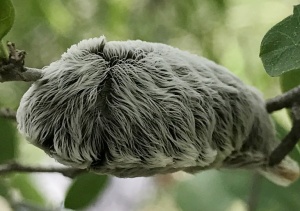
It’s a caterpillar of the southern flannel moth, Megalopyge opercularis, in its last instar state. It’s the best known flannel moth and stinging caterpillar in Texas.
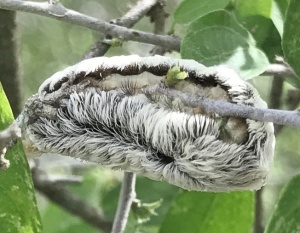
The larval form has several names: puss caterpillar, asp, Italian asp, woolly slug, opossum bug, puss moth, or asp caterpillar. Its habitat is deciduous forests and has many host plants including hackberry, oak, orange, pecan, roses and other trees and shrubs.
We found this dude in a granjeno (spiny hackberry) tree in the Betty McEnery Memorial Garden on Ebony Loop in Hugh Ramsey Nature Park recently during a Thursday volunteer work day.
Another was found 18 months ago around the Loop in Runyon Garden; a volunteer dropped it on Frank Wiseman’s open palm so we could all look at it. Someone shrieked, “Asp, it stings!”
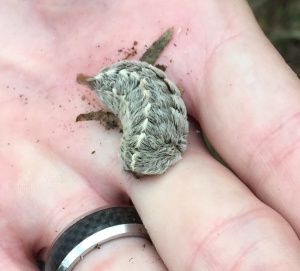
Frank-the-asp-whisperer carefully placed it back in a shrub. We still talk about how amazing it was that it didn’t sting him.
The southern flannel moth caterpillar is considered a dangerous insect because of its venomous spines which cause “immediate hemorrhagic papular eruption with severe radiating pain,” — to those of medical persuasion.
My lay-person interpretation: severe rash with volcano-like welts — in a grid that matches the pattern of venomous spines at the underside of the asp, no less!
The pain has been described as similar to a broken bone or blunt force trauma — enough warning for me to leave this guy alone.
The adult southern flannel moth, on the other hand, also fuzzy and cute, doesn’t warrant warnings.
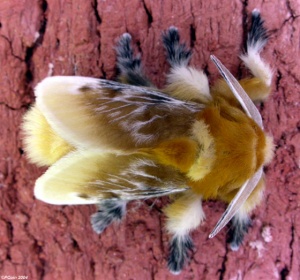
As a matter of fact, moths can’t bite or sting. They pollinate plants, including night-blooming species. In the food chain, adult moths, and their caterpillars, are important food for a wide variety of wildlife, including other insects, spiders, frogs, toads and birds. Moths make up a major part of the diet of bats.
As for caterpillars in general, a good rule of thumb is, if it looks spiny, spiky or furry, do not pick it up, as it most likely is able to sting.
This pretty, compact yellow fuzzy-wuzzy is most likely a banded tussock moth or pale tiger moth Halysidota tessellaris. If anyone knows differently, please let me know.
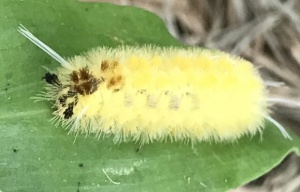
Quick Quiz:
Would you pick up this cute little fella and let it crawl up your arm?
Good answer, if your first thought is, no! These furry cats are true to the moth general rule of thumb: they carry venom in various hairs and at the base of the tussocks. Depending on a person’s sensitivity, this cute cat could cause an itching rash that could irritate you for two or three days.
This spiky, banded, black caterpillar may be the giant leopard moth, Hypercompe scribonia.
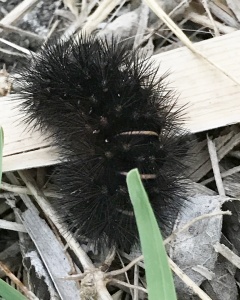
A common larval name is giant woolly bear. If it indeed is, it’s not poisonous, contrary to the general rule. They lack stinging spines and do not bite. It uses a variety of plants as host including orange, sunflowers and banana. This one was near a stand of plantains.
However, the bands on it seem to be tan, whereas research indicates the bands of the giant leopard moth cat to be orange or red. Like all caterpillars, it has different appearances at instar stages. This pretty cat could, perhaps, be a many-spotted tiger moth, Hypercompe permaculata, caterpillar. To be safe, I adhered to the general rule of thumb about furry cats and did not handle it. You just never know . . . .
The adult giant leopard moth is white with black spots/rings and a three-inch wingspan. The many-spotted tiger moth is white with black polka-dots and a smaller wingspan. We have quite a collection of moths and bugs because of a security light above the garage — a photographic gallery of mystery — or perhaps, a smorgasbord for those that eat moths.
This colorful beetle-looking critter might fool you at first glance. It’s not a beetle, it’s an Ailanthus webworm moth that likes to keep its wings close to its body.
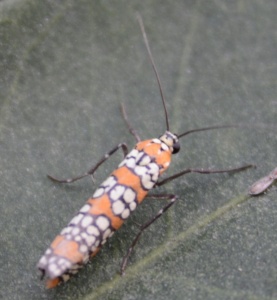
The white rosette flower motif covers its forewings. The hindwings are opaque, making it look like a wasp when it flies. It’s a daytime flower pollinator.
Now for some good old fashioned folk lore — this is a moth you want to stay a while.
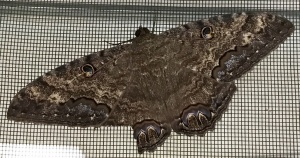
The black witch, Ascalapha odorata, is the largest moth north of Mexico with a seven-inch wing span.
June to October is its fly time in the Rio Grande Valley. Its caterpillars eat legumes, and favor acacia and mesquite. Both the adult and caterpillars are harmless to people; neither have teeth nor stingers. The caterpillar is smooth-skinned, black and tan with a head that resembles a military fighter pilot’s helmet.
Black witch moths are nocturnal. If you see them during the daytime, they’re resting — usually under eaves, in patios, garages, and porches. They fly when disturbed, generally into a person’s face and then off over a shoulder before you can say, Bob’s your uncle. They are nectarous, and also attracted to soft, overripe fruit, if you want to be hospitable.
Here’s some of the myth surrounding the black witch moth. In Mexico, they are known as the butterfly of death. Some believe if a black witch moth enters the home of someone who is ill, the person will die. Another version suggests that the moth must travel to each corner of the house for death to occur.
On a brighter note, in the Caribbean, the black witch moth is known as the money moth and if it visits your home, you’re likely to come into cash. Here in the Valley, it is believed that if the moth roosts over your door, you will win the lottery. — I’m going with that one. I’ve put some fruit on the porch for our visitor.
Love the way you bring these obscure creatures to life for those of us not into entomology. Thanks, Anita!
Thank you for appreciating the blogs, Sally. Not being an original Texan, I find I want to know what I’m living around — there’s always something in the butterfly garden other than butterflies!